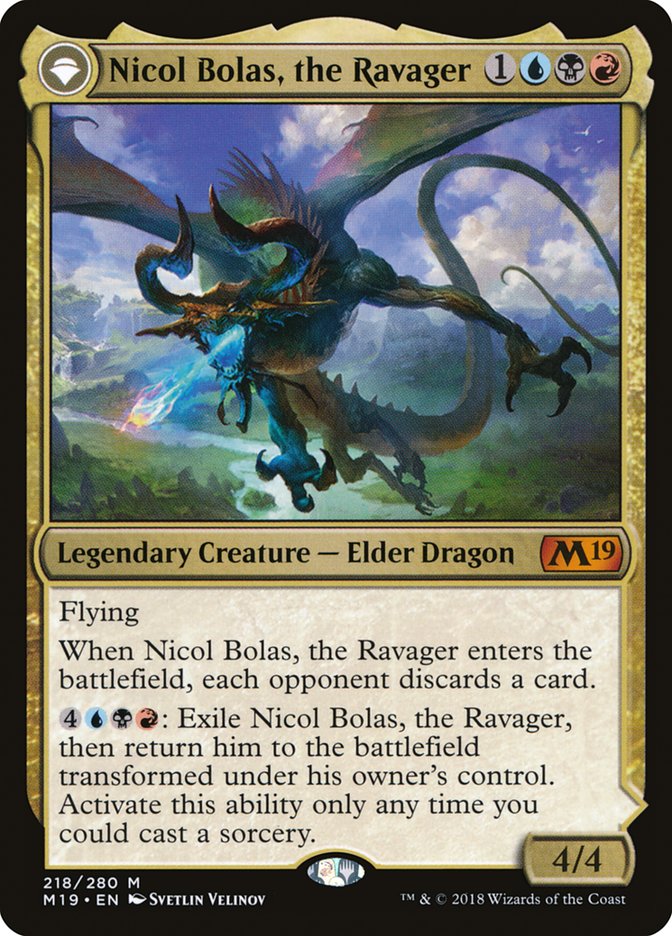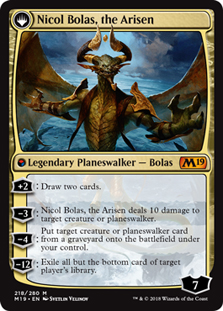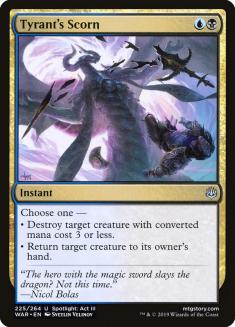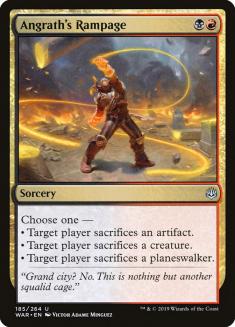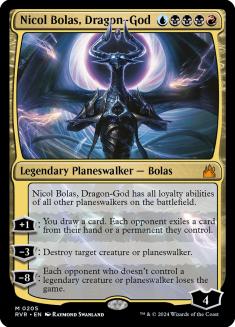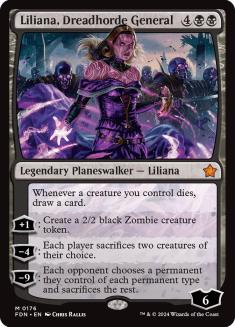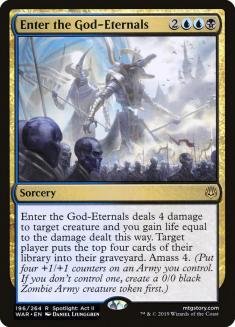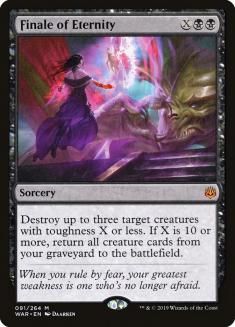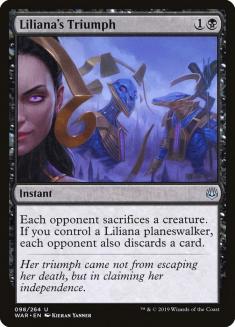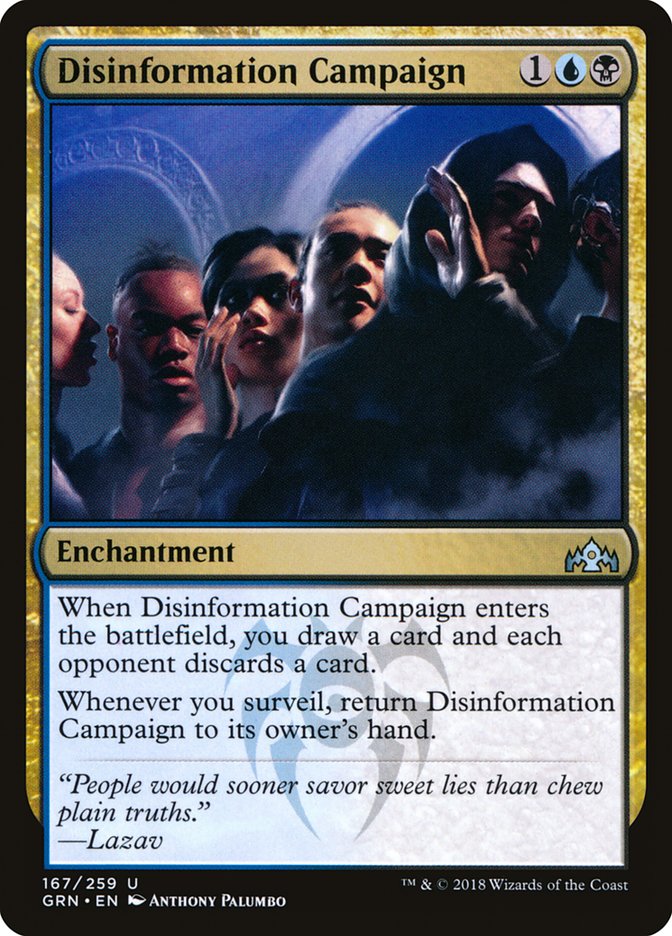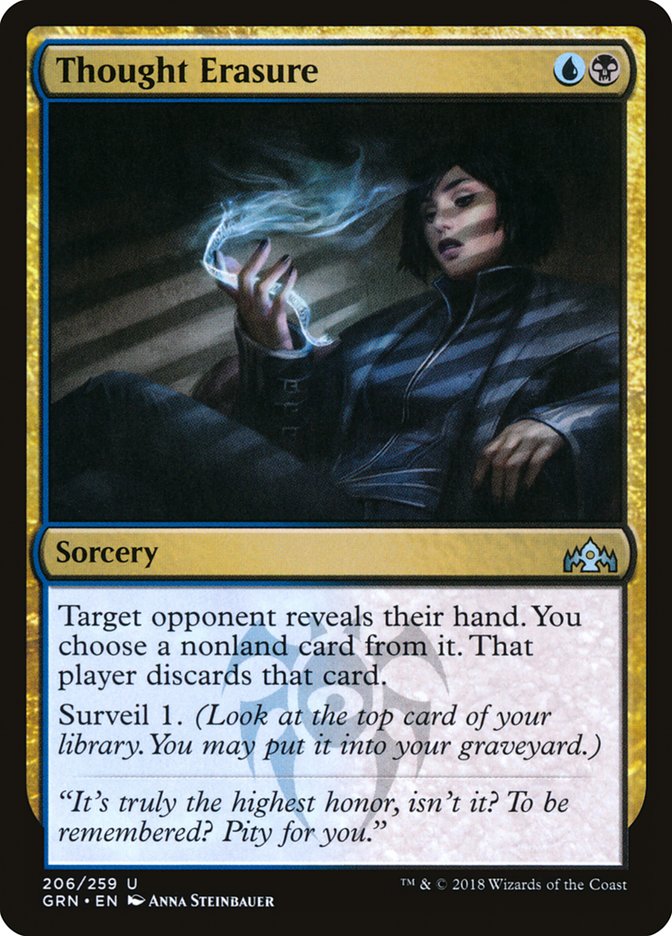War of the Spark Standard has gotten well underway, thanks to the early release of the set on Magic Online and Magic Arena. Players have already begun to get their hands dirty, testing the cards that have generated the most buzz and shown the most promise leading up to now. As for me, I spent the first day or so trying basically everything under the sun that I could think of. Many of the preexisting decks in Standard got significant upgrades across the board and it’s likely that a new archetype or two will spawn from the powerhouses that make up this set.
Grixis decks stood to gain a lot from this set’s release, poised to finally have the missing ingredients available to create the perfect recipe for success. The shell has shown up here and there over the course of the last year or so, in part due to the significant standalone power of a card printed all the way back in Core Set 2019:
The problem with poor Bolas is that the supporting cast of threats and answers surrounding him have never been quite good enough. A series of factors in the last couple Standard formats have led to this deck sitting in the shadows, waiting for any potential opportunity to become strong enough to compete in Standard.
Identity Crisis
Due to the lack of viable three-mana options in the archetype, Grixis has had to play spells like Sinister Sabotage or Ionize to bridge its way into the late-game. Most of the other spells in the deck are typically sorcery-speed, tap-out spells, meaning there quickly becomes a tension between holding up mana to counter a crucial spell and tapping out to play something like Nicol Bolas, the Ravager. Let’s examine a list I was able to find from last Standard on Magic Online:
Creatures (9)
Lands (25)
Spells (26)
- 2 Duress
- 4 The Eldest Reborn
- 4 Thought Erasure
- 4 Sinister Sabotage
- 4 Lava Coil
- 3 Disinformation Campaign
- 3 Bedevil
- 2 Cry of the Carnarium
Sideboard

The deck, as it stood, was just plain clunky. The mishmash of cards like maindeck Hostage Taker, Dream Eater, Duress, and Cry of the Carnarium, plus a full set of The Eldest Reborn, all with little to no card draw or deck manipulation, means that this deck needed a lot to go right to function properly.
Missing Tools
By examining the decklist above once more, we see a handful of incredibly conditional and clunky answers and threats, all tied together with a Grixis manabase that only features essentially Nicol Bolas, the Ravager as a payoff. As it is currently built, it’s easy to see why you would not really be interested in Grixis as your Thought Erasure control deck of choice over something like Esper, a deck that has:
- A smooth curve from top to bottom.
- A premier counterspell with anti-aggro utility in Absorb.
- Teferi, Hero of Dominaria, of course.
- An unconditional four-mana sweeper in Kaya’s Wrath, challenging casting cost notwithstanding.
- Card draw and ability to pitch dead cards thanks to Chemister’s Insight.
Grixis didn’t have the combination of flexibility and power that Esper showcased throughout the entirety of Ravnica Allegiance season. Things have taken a turn for the better for the Grixis cabal, however.
Enter: War of the Spark
Some of the most powerful cards in War of the Spark are in the Grixis colors and cover everything from powerful removal spells to absolute haymaker win conditions.
War of the Spark really ramped up the power of answers for controlling and midrange-style decks. Tyrant’s Scorn and Angrath’s Rampage provide early interaction that is both flexible and broad. Finale of Eternity provides a scaling sweeper that can deal with a handful of one-toughness creatures on Turn 3 while having the ability to deal with bigger creatures deep into the game. Additionally, the deck can do away with not-so-great win conditions like Dream Eater and Hostage Taker in place of a five-mana planeswalker able to give Teferi, Hero of Dominaria a run for his money.
Putting it all together, I started my testing with this:
Creatures (7)
Planeswalkers (5)
Lands (26)
Spells (22)
- 4 Thought Erasure
- 4 Chemister's Insight
- 2 Discovery
- 3 Bedevil
- 2 Cry of the Carnarium
- 2 Angrath's Rampage
- 3 Enter the God-Eternals
- 2 Tyrant's Scorn
Sideboard

Gone are nonsense cards like Lava Coil which, while fine in their own right, don’t have nearly the same flexibility that Tyrant’s Scorn and Angrath’s Rampage do. Discovery // Dispersal helps smooth out your draws in the early- and mid-game and can even sometimes use Dispersal to permanently eliminate problematic permanents. This is because the deck utilizes so much hand disruption with Thought Erasure, either version of Nicol Bolas, and sideboarded copies of Duress, which help you constantly keep your opponent’s hand under pressure and run them out of resources capable of winning the game.
Liliana, Dreadhorde General sits at the top of the curve, serving as an excellent way to stabilize the battlefield by making your opponent sacrifice two creatures. Enter the God-Eternals also slams the door shut a lot of the time against any aggressive deck and is even solid against the midrange decks to help stabilize the battlefield.
My biggest problem with this deck continued to be the three-drop slot. Lots of great options exist, but they’re all fairly contextual and metagame-dependent. For example, in the list above, I utilized the full set of Thief of Sanity to have a proactive plan that would work well in any mirror match, against Esper Control, or against any of the Nexus of Fate decks, but Thief is likely the last card I would want to see against any of the more aggressive decks and it’s reasonable to assume that those decks will be more popular than normal at SCG Richmond this weekend.
I also included Chemister’s Insight in this list to emulate Esper’s ability to filter out some of the dead draws, but it conflicted too much with the deck’s late-game and I really only felt that my cards were ever truly dead against Esper, a matchup that I felt favored anyway (especially in the sideboarded games).
I felt like the deck still needed to move farther towards being mostly proactive and found myself a very big fan of the plan of cutting my opponent’s hand size down with all my discard effects. To that end, I decided to try adding in a Guilds of Ravnica Limited all-star with good synergy with the other surveil cards in my deck:
While Disinformation Campaign has little effect on the battlefield, it helps work with Thought Erasure and Nicol Bolas, the Ravager to create a devastating curve of spells that leave your opponent with a lot to deal with and very few resources to do it. Let’s observe:
This curve does little to affect the battlefield itself until Turn 4, so it can create some issues against very aggressive decks, but this curve usually leaves Nicol Bolas, the Ravager to freely dominate the battlefield against said aggressive decks, and against more controlling decks like Esper, you can use Thought Erasure to surgically poke the hole in their hand to let the rest of the curve resolve.
My newer list utilizing this engine is the following:
Creatures (4)
Planeswalkers (5)
Lands (25)
Spells (26)

The cards outside of the discard engine now aim to shore up aggressive matchups, featuring maindeck Moment of Craving, Cry of the Carnarium, and Ritual of Soot. I shaved a copy of Enter the God-Eternals and moved it to the sideboard, as I think I want three in the matchups where it is good, since it is typically a very hot or cold card depending on the matchups. The four copies of Thief of Sanity have been relegated to the sideboard to make room for the Disinformation Campaigns, as it is also a card that’s strong in the right matchup but likely too narrow for the maindeck.
I think the biggest problem that Grixis had in this Standard format – not having enough playables – has been replaced with essentially the exact opposite problem; the tools are all here now, but the best combination of cards is fairly challenging to piece together. After playing with a bunch of different builds, I think playing on the strengths of the cards that you’re 100% interested in playing with by piling on the hand disruption engine before taking over the game with unbeatable threats is a viable strategy.
Many players will likely still find it too difficult to divorce themselves from their love of Teferi, Hero of Dominaria and the supporting cast of cards that made Esper Control so strong in Ravnica Allegiance Standard. However, after many agonizing months of Nicol Bolas, the Ravager and company sitting on the sidelines, the Dragon-God planeswalker and some other powerful red, blue, and/or black spells have given Grixis a critical mass of playables to give the deck a powerful, proactive gameplan that can pivot and react to shifts in the metagame. I would advise the second Grixis Bolas deck as a very solid general list that will cover much of what I predict will show up at SCG Richmond this weekend.
Things may change in the coming weeks, but I think I’ve found a quality recipe for success for Grixis in early War of the Spark Standard.


